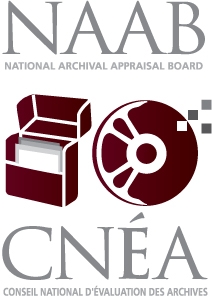 |
|
Services
NAAB’s Services Appraisal panels are generally appointed by a regional coordinator. A NAAB appraisal panel is usually composed of at least one archivist, one researcher and one dealer. In special cases, additional members may be appointed when the nature of the material requires particular expertise. NAAB appraisal panels are responsible for the determination of the fair market value of the archival donations submitted by the institution. The definition of the fair market value is that used by the Canadian Cultural Property Export Review Board; it is understood to be “the highest price, expressed in terms of money, that the property would bring in an open and unrestricted market between a willing buyer and a willing seller who are both knowledgeable, informed, and prudent, and who are acting independently of each other”.
When the regional coordinator has received a request from an institution, he/she will schedule an appraisal session and appoints the members of the Appraisal Panel for that session. NAAB is prepared to do an appraisal within ten days of receiving a finding aid that generally makes it possible to review the content description and listing before our arrival. The finding aid should include an administrative/biographical note, scope and content note, physical extent, significance and highlights of the collection. Appraisers will not be able to view or audition all items in a large fonds, therefore a sample selection of documents within the fonds, representing its strengths and weakness and different genres of documents is helpful. Large donations that contain photographs should include the number and sizes of each of the various photographic formats eg. number of 5x7s, 8x10s, 11x14s etc. and also indicate the same should there be any transparencies and/or slides. Once the on-site appraisal has been undertaken, a report is prepared that can be used by the institution to issue the necessary income tax receipt. Please advise us if it is your intention to prepare an application to the Canadian Cultural Property Export Review Board. | Les services du CNÉA Les panels d’évaluation sont habituellement formés par le coordonnateur régional. Un panel d’évaluation se compose normalement d’au moins un archiviste, d’un chercheur et d’un marchand. Ses membres sont des archivistes, des historiens et des marchands de livres et manuscrits choisis selon leurs connaissances des archives et des conditions du marché et leur aptitude à évaluer la valeur de recherche et l’intérêt institutionnel de document et de fonds spécifiques. D’autres types d’experts peuvent s’adjoindre à un panel, lorsque nécessaire, pour aider à l’évaluation d’un don présentant des caractéristiques particulières. Les panels d’évaluation sont responsables de l’établissement de la juste valeur marchande des dons qui leur sont présentés par une institution. La définition de la juste valeur marchande est celle qui est utilisée par la Commission d’examen des exportations de biens culturels; on comprend qu’elle est « le prix le plus élevé, exprimé en espèces, qu’un bien rapporterait sur le marché libre, dans une transaction entre un vendeur et un acheteur consentants qui seraient indépendants l’un de l’autre et qui agiraient en toute connaissance de cause ».
Lorsqu’il reçoit une demande d’une institution, le coordonnateur régional organise une séance d’évaluation et nomme les membres du Panel d’évaluation de cette séance. Le CNÉA est prêt à faire une évaluation dans les dix jours suivant la réception d’instruments de recherche permettant d’examiner la description et le contenu des documents avant son arrivée. L’instrument de recherche doit être accompagné d’une note administrative/bibliographique, d’une précisant l’envergure et le contenu, l’ampleur physique, l’importance et les éléments saillants de la collection. Les évaluateurs ne pourront regarder ou écouter tous les éléments d’un fonds important, c’est pourquoi il est utile de fournir un échantillon de documents du fonds représentant ses forces et ses faiblesses et différents types de documents. Les grands dons contenant des photographies devraient inclure le nombre et les dimensions de chaque format photographique – p. ex., le nombre de 5x7, 8x10, 11x14, etc. – et faire de même pour les transparents et/ou diapositives. Après l’évaluation sur place, nous rédigeons un rapport que l’institution peut utiliser pour émettre un reçu aux fins de l’impôt. Vous devez mentionner si vous comptez soumettre une demande à la Commission canadienne d’examen des exportations de biens culturels. |
NAAB Secretariat / Secrétariat du CNÉA |
